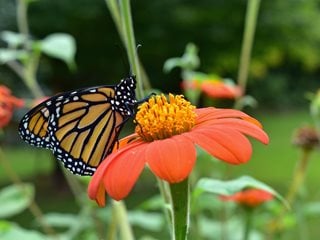How to Grow Mexican Sunflowers (Tithonia)
Brighten up the back of the border with these tall, sun-loving bloomers.
Photo by: Larry Burk / Shutterstock
Every garden needs a big, bold focal point that serves as an eye-catching vertical element, much like the role of a thriller plant in container displays. Mexican sunflower—a large, fast-growing annual that can grow to shoulder-height or taller—is ideal for that purpose.
A relative of the zinnia and the common sunflower, this showy member of the aster family resembles both, with brightly colored daisy-like flowers accented by sunny yellow centers. In addition to its striking beauty, Mexican sunflower is one of the best plants you can grow to attract butterflies and other pollinators to your garden and is a particular favorite of the monarch butterfly.
On this page: Basics | Growing | Care | Varieties
On this page:
BASICS
Botanical name:
Tithonia rotundifolia
Note: Not to be confused with Tithonia diversifolia, or Bolivian sunflower, an even larger species that is considered to be invasive in some areas.
Common names:
Mexican sunflower, tree marigold, tithonia, red sunflower
Native range:
Native to Mexico and Central America
Exposure:
Full sun, 6+ hours per day
Height/spread:
3 to 6 feet tall, 2 to 3 feet wide
Bloom time:
Mid-summer to frost
Flower colors:
Orange, red, or yellow
Special attributes:
- Attracts bees, butterflies, and hummingbirds
- Drought tolerant
- Easy to start from seed
- Deer and pest resistant
- Excellent for use as cut flowers
GROWING MEXICAN SUNFLOWERS

Bee on 'Fiesta del Sol' tithonia. Photo by: ISmiths / Shutterstock
When to plant:
In spring, after all danger of frost has passed. As a general rule of thumb, wait until nighttime temperatures rise above 60° F before putting your plants in the ground.
Where to plant:
Because of its tall stature, Mexican sunflower works best at the back of garden beds and borders to form a backdrop for shorter plants. For the most prolific display of blooms, plant in a spot that receives full sun (at least 6 hours daily). The stems of Tithonia tend to be brittle, so find a location sheltered from strong winds, such as alongside a fence or garden wall.
Soil:
Tithonia plants thrive in poor to average, well-drained soil, including rocky or sandy soils. Avoid planting in rich, fertile soil, which will result in excess foliage growth and weak stems.
How to plant:
Although Mexican sunflowers can be started from purchased plants, they are most commonly propagated from seed, either sowed directly in the garden once the soil warms up in spring or started indoors 6 to 8 weeks before the last frost date. In colder climates (zone 4 or below), starting seeds indoors will ensure blooms in time for summer. Because light is required for germination, just barely press the seeds into the soil or potting mix. It will take the seeds 2 to 3 weeks to germinate when kept at a temperature of 70° to 80° F.
Spacing:
In the garden, space plants about 2 to 4 feet apart, depending on their width at maturity. Allow enough space between plants to ensure good air circulation, which will help prevent the development of powdery mildew.
Growing in containers:
You can find dwarf varieties of Mexican sunflower (such as ‘Fiesta del Sol’) ideal for growing in pots on a patio, deck or balcony. Choose a container with holes for good drainage and one large enough to accommodate the size of the plant at maturity. Generally, a 5-gallon pot will provide enough growing room for one plant. If starting your sunflowers from seed, plant only a few seeds in each pot and then thin to the strongest seedlings later.
MEXICAN SUNFLOWER CARE
Watering:
Water Mexican sunflower plants regularly until they become established. After they take root, the plants are drought tolerant and will need supplemental watering only during dry spells.
Fertilizing:
Tithonia needs no fertilization to put on a continual display of blooms. In fact, applying fertilizer can even be detrimental and may inhibit flowering.
Staking:
Mexican sunflowers that grow over 3 feet tall will often require staking to prevent the stems from breaking due to strong winds or heavy rain. Another option is to pinch plants back to encourage bushier growth and sturdier stems that are more likely to remain upright without added support.
Deadheading and pruning:
Mexican sunflower should be deadheaded regularly to promote more blooms and prolong the flowering period. Near the end of the growing season, leave a few of the spent flowerheads in place so you can collect and save the seeds.
If your plants become too tall and lanky, you can shear them back by about one-third to get them under control and encourage a new flush of blooms. The cut flowers removed during pruning are great for use in floral displays.
Pests and diseases:
Mexican sunflowers have no serious insect or disease problems, but be on the lookout for slugs and snails, which may become a problem after extended periods of rain.
MEXICAN SUNFLOWER VARIETIES
'TORCH'
This old-fashioned cultivar, named an All-America Selections (AAS) winner in 1951, continues to be one of the most popular, bearing vibrant red-orange blooms measuring more than 3 inches across. Grows to a height of 5 to 6 feet.
'FIESTA DEL SOL'
Another AAS award winner, this dwarf variety grows to a height of only 3 feet and produces an abundance of bright orange, daisy-like flowers. An excellent addition to a cutting garden.
'YELLOW TORCH'
Similar to ‘Torch’ but with brilliant canary-yellow flowers. Can grow to over 6 feet tall, so be sure to provide a strong support at planting time.












